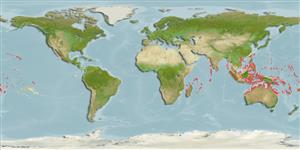Common names from other countries
Environment: milieu / climate zone / depth range / distribution range
Ekologi
laut berasosiasi dengan karang; nir-ruaya; kisaran kedalaman 0 - 20 m (Ref. 9710), usually 2 - 15 m (Ref. 37816). Tropical; 26°N - 25°S
Indo-Pacific: East Africa to Mangaréva, Tuamoto Islands and the Hawaiian Islands, north to Taiwan; throughout Micronesia.
Size / Weight / umur
Maturity: Lm ? range ? - ? cm
Max length : 8.5 cm SL jantan/; (Ref. 9710)
Duri punggung (Keseluruhan (total)): 10; duri punggung lunak (Keseluruhan (total)): 12; Duri dubur 3; Sirip dubur lunak: 6. Irregular dark bars on body which may be broken into spots; 2 narrow diagonal bars on cheek; opercle and base of soft dorsal with large ocellated black spot (Ref. 5469).
A secretive species remaining in or near interstices of rock, coral, or rubble (Ref. 2334, 58302). Moderately common in seaward reefs in areas exposed to moderate surge or currents (Ref. 2334). Feeds on small crustaceans (Ref. 89972). Benthic (Ref. 58302). Minimum depth reported from Ref. 30874.
Life cycle and mating behavior
Kematangan | Reproduksi, perkembang biakan | Pemijahan | telur-telur | Fecundity | Larva
Randall, J.E., G.R. Allen and R.C. Steene, 1990. Fishes of the Great Barrier Reef and Coral Sea. University of Hawaii Press, Honolulu, Hawaii. 506 p. (Ref. 2334)
Status IUCN Red List (Ref. 130435)
CITES (Ref. 128078)
Not Evaluated
ancaman kepada manusia
Harmless
penggunaan manusia
Akuarium: Komersial
informasi lanjut
AcuanBudidaya airprofil budidaya airStrainGenetikaElectrophoresesDiturunkanPenyakit-penyakitPengolahanMass conversion
mitraGambarStamps, Coins Misc.Suara-suaraCiguateraKecepatanTipe renangArea insangOtolithsOtakPenglihatan / visi
Alat, peralatan
laporan khas
muat turun XML
Sumber internet
Estimates based on models
Preferred temperature (Ref.
115969): 25.2 - 29.3, mean 28.4 (based on 2558 cells).
Phylogenetic diversity index (Ref.
82804): PD
50 = 0.5312 [Uniqueness, from 0.5 = low to 2.0 = high].
Bayesian length-weight: a=0.01585 (0.00637 - 0.03944), b=3.01 (2.79 - 3.23), in cm Total Length, based on LWR estimates for this (Sub)family-body shape (Ref.
93245).
Trophic level (Ref.
69278): 3.5 ±0.6 se; based on size and trophs of closest relatives
Fishing Vulnerability (Ref.
59153): Low vulnerability (10 of 100).
